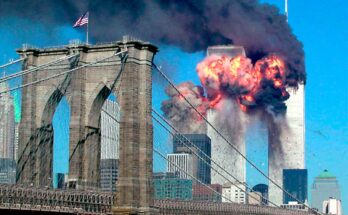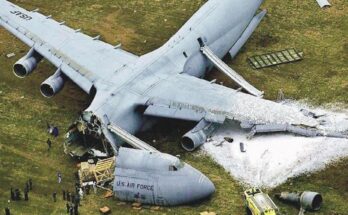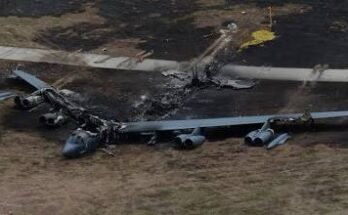
A devastating tragedy struck an airshow as a U.S. Navy Blue Angels jet crashed, killing the pilot. The incident, which occurred during a high-speed performance, left spectators in shock and mourning as emergency responders rushed to the scene. This heartbreaking event has raised questions about the risks associated with aerobatic displays and the safety measures in place to protect both pilots and audiences.
The Fatal Crash
The accident occurred during a scheduled airshow, where the Blue Angels, the U.S. Navy’s elite flight demonstration squadron, were performing. Witnesses reported seeing the aircraft executing a high-speed maneuver before losing control and plunging toward the ground. The pilot, unable to eject in time, tragically lost his life upon impact.
Airshow officials and military investigators quickly responded to the crash, securing the site and initiating an investigation into the cause of the accident. Preliminary reports suggested that mechanical failure or a miscalculation in maneuver execution could have played a role, but a full inquiry will determine the exact circumstances leading to the crash.
A Legacy of Excellence and Danger
The Blue Angels have long been a symbol of precision, skill, and excellence in aerial performance. Established in 1946, the team has inspired millions worldwide with breathtaking aerobatics that push the limits of aviation. However, the danger associated with these performances is ever-present.
Since their inception, the Blue Angels have experienced multiple crashes, resulting in the loss of skilled pilots. The high-speed, low-altitude maneuvers they execute demand split-second decisions and extreme precision. Despite rigorous training and adherence to safety protocols, accidents have occurred, underscoring the inherent risks of the profession.

The Pilot: A Hero Remembered
The pilot who perished in the crash was a highly experienced aviator with years of service in the Navy. His dedication to the Blue Angels was evident in his commitment to the rigorous training and discipline required to fly in one of the world’s most elite demonstration squads.
Tributes poured in from fellow servicemen, aviation enthusiasts, and citizens across the country. Many described him as a hero who lived his dream and inspired countless others to pursue aviation careers. The loss is deeply felt within the military community and beyond, as he represented the bravery and skill that define naval aviators.
Investigating the Cause
In the wake of the tragedy, the U.S. Navy has launched an extensive investigation into the crash. Aviation experts will analyze flight data, mechanical components, and eyewitness accounts to determine what went wrong. The findings could lead to changes in safety protocols, training adjustments, or modifications to the aircraft to prevent similar accidents in the future.
Military aviation accidents often lead to significant reforms in pilot training and aircraft maintenance. If mechanical failure is found to be the cause, it could prompt inspections of other Blue Angels jets. If pilot error is determined, it may result in adjustments to training programs to enhance safety procedures.
Impact on Air Shows and Aviation Safety
This tragedy raises concerns about the safety of airshows, which attract millions of spectators annually. While these events showcase the incredible capabilities of military and civilian pilots, they also come with risks. Critics argue that extreme aerobatic performances at low altitudes leave little room for error, making accidents catastrophic.
Despite the risks, airshows remain a significant part of military and aviation culture. They serve to inspire, recruit, and educate the public about aviation. The challenge for organizers is to balance excitement with safety, ensuring that pilots and spectators remain protected.
Mourning and Moving Forward
The loss of a Blue Angels pilot is a profound tragedy that reverberates throughout the military and aviation communities. As the investigation continues, efforts will be made to honor the pilot’s legacy while ensuring that lessons are learned to prevent future accidents.

The Blue Angels, despite this heartbreaking loss, will continue their mission of inspiring and demonstrating the skill of naval aviation. Their performances serve as a tribute to those who have given their lives in service to their country, reminding the world of the courage and dedication required to soar through the skies.


